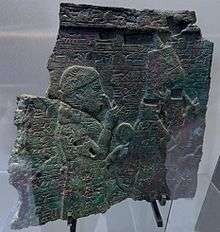Naqi'a
Naqi’a (c. 730 – 668 BC, Assyria) held an advisory position to the throne under the title of queen mother during the reigns of Esarhaddon and Ashurbanipal, her son and grandson.

Biography
Origins
The only thing we know of Naqi'a's family is that she had a sister, Abi-rami.[1]
Because Naqia sometimes adopted the Akkadian name Zakutu, a translation of Naqi'a, scholars have assumed that she was not native to Assyria. Some scholars suggest that Naqia was Hebrew while others contend that she was one of the women that Hezekiah sent to Sennacherib in 701 BC.[1]
Naqia was probably born in Babylonia, but her family may have originated in the Harran area. The suggestion that Naqia originally came from the West is based on the fragment of a bronze relief now in the Louvre, where Naqia is depicted standing behind the king. She holds a mirror in her left hand and a plant in her right hand. Scholars point out that the motif of a woman holding a mirror is Syrian/Anatolian in origin and appears in Assyrian art here for the first time.[1]
Reign of Sennacherib
Naqi’a joined Sennacherib's harem and bore a son, Esarhaddon, around 713 BC.[1] After the murder of Sennacherib's eldest son, Assur-nadin-sumi, in 694, Sennacherib waited almost eleven years before designating another heir. Eventually he named Esarhaddon, his youngest son, to the post, thus supplanting his eldest son, Arda-Mulissu, who as eldest son had expected to succeed his father. During the brief two-year period when Esarhaddon was crown prince, he and his mother had to strive constantly to maintain their positions. Eventually, Esarhaddon was forced to go into hiding. Naqi'a does not appear in our sources until Esarhaddon's promotion and it is not certain when, if at all, Naqi'a achieved first wife status.[1]
Reign of son
She was at court in Nineveh when her husband was murdered and remained there through the ensuing troubles, during which time she sought news of the future from prophetesses. Most of our information dates to the reign of her son, Esarhaddon. To this period belong the letters addressed to her and those in which she is mentioned. We also have the building inscription from a palace that she had built for Esarhaddon, two dedicatory inscriptions, and administrative and economic documents indicating that she was very wealthy and supported a large household staff. When her son died she imposed a loyalty oath on behalf of her grandson, Ashurbanipal, and, although she may have lived longer, that is the last evidence we have of her.[1]
References
- Melville, Sarah C. (1999). The role of Naqia/Zakutu in Sargonid politics. Helsinki: Neo-Assyrian Text Corpus Project. ISBN 9514590406.